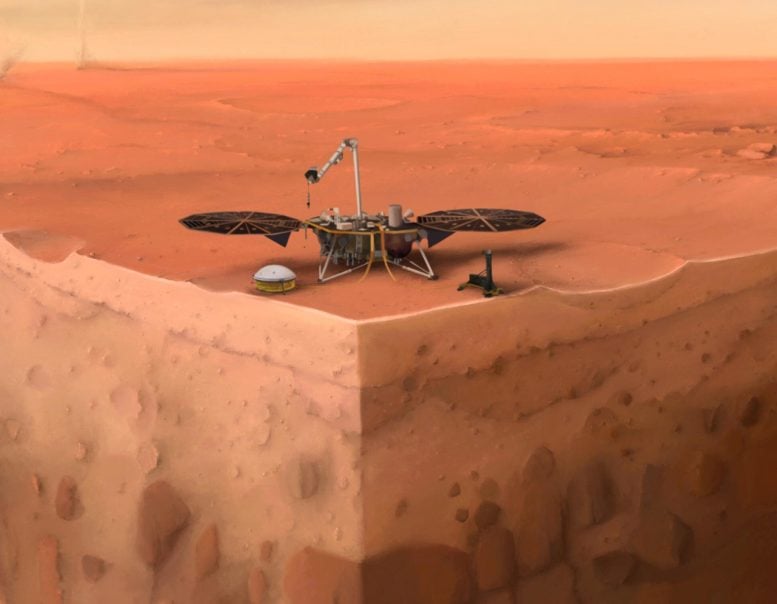New analysis reveals that Mars’ mantle holds evidence of its turbulent early history.
New research published in Science shows that Mars’ mantle retains evidence of its violent origins.
The planet’s interior is not the smooth, uniform structure often shown in textbook diagrams. Instead, scientists found it to be irregular and fragmented, resembling a Rocky Road brownie more than the neatly layered slice of a millionaire’s shortbread.
We usually imagine rocky planets like Earth and Mars as having clean, stratified interiors, with crust, mantle, and core stacked like distinct layers of dessert. But in the case of Mars, the structure is far more chaotic.
Data from seismic waves recorded by NASA’s InSight mission revealed subtle irregularities that pointed to this complexity. Researchers from Imperial College London and collaborating institutions determined that Mars’ mantle contains ancient blocks as large as 4 kilometers across. These preserved fragments act as geological fossils, offering a direct record of the violent events that shaped the planet in its earliest history.

History of gigantic impacts
Mars, along with the other rocky planets, formed about 4.5 billion years ago as dust and rock around the young Sun gradually clumped together under gravity.
After its initial formation, Mars was battered by massive, planet-scale collisions—events similar to the one believed to have created Earth’s Moon.
“These colossal impacts unleashed enough energy to melt large parts of the young planet into vast magma oceans,” said lead researcher Dr Constantinos Charalambous from the Department of Electrical and Electronic Engineering at Imperial College London. “As those magma oceans cooled and crystallised, they left behind compositionally distinct chunks of material – and we believe it’s these we’re now detecting deep inside Mars.”
These colossal impacts and their aftermath shattered and stirred fragments of Mars’ early crust and mantle, possibly blending in debris from the colliding bodies, before folding them into the planet’s molten interior. As the planet gradually cooled, these chemically varied pieces became locked within a sluggish, unevenly convecting mantle, resembling ingredients suspended in a Rocky Road brownie mixture rather than being blended into a smooth whole.

In contrast to Earth, where plate tectonics continually reshuffle and recycle crust and mantle material, Mars developed a rigid outer shell early on. This stagnant crust prevented further large-scale mixing, leaving its interior preserved as a geological time capsule.
“Most of this chaos likely unfolded in Mars’s first 100 million years,” says Dr Charalambous. “The fact that we can still detect its traces after four and a half billion years shows just how sluggishly Mars’s interior has been churning ever since.”
Listening into Mars
The evidence comes from seismic data recorded by NASA’s InSight lander – in particular, eight especially clear marsquakes, including two triggered by two recent meteorite impacts that left 150-metre-wide craters in Mars’s surface.
InSight picks up seismic waves travelling through the mantle and the scientists could see that waves of higher frequencies took longer to reach its sensors from the impact site. These signs of interference, they say, shows that the interior is chunky rather than smooth.
“These signals showed clear signs of interference as they travelled through Mars’s deep interior,” said Dr Charalambous. “That’s consistent with a mantle full of structures of different compositional origins – leftovers from Mars’s early days.”
“What happened on Mars is that, after those early events, the surface solidified into a stagnant lid,” he explained. “It sealed off the mantle beneath, locking in those ancient chaotic features — like a planetary time capsule.”
Unlike the interior of Earth
Earth’s crust, by comparison, is always slowly shifting and recycling material from the surface into our planet’s mantle – at tectonic plates such as the Cascadia subduction zone where some of the plates forming the Pacific Ocean floor are pushed under the North American continental plate.
The chunks detected in Mars’s mantle follow a striking pattern, with a few large fragments – up to 4 km wide – surrounded by many smaller ones.
Professor Tom Pike, who worked with Dr Charalambous to unravel what caused these chunks, said: “What we are seeing is a ’fractal’ distribution, which happens when the energy from a cataclysmic collision overwhelms the strength of an object. You see the same effect when a glass falls onto a tiled floor as when a meteorite collides with a planet: it breaks into a few big shards and a large number of smaller pieces. It’s remarkable that we can still detect this distribution today.”
The finding could have implications for our understanding of how the other rocky planets – like Venus and Mercury – evolved over billions of years. This new discovery of Mars’s preserved interior offers a rare glimpse into what might lie hidden beneath the surface of stagnant worlds.
“InSight’s data continues to reshape how we think about the formation of rocky planets, and Mars in particular,” said Dr Mark Panning of NASA’s Jet Propulsion Laboratory in Southern California. JPL led the InSight mission before its end in 2022. “It’s exciting to see scientists making new discoveries with the quakes we detected!”
Reference: “Seismic evidence for a highly heterogeneous martian mantle” by Constantinos Charalambous, W. Thomas Pike, Doyeon Kim, Henri Samuel, Benjamin Fernando, Carys Bill, Philippe Lognonné and W. Bruce Banerdt, 28 August 2025, Science.
DOI: 10.1126/science.adk4292
Funding: UK Space Agency, UK Space Agency, Johns Hopkins University, NASA InSight mission, Jet Propulsion Laboratory, California Institute of Technology, National Aeronautics and Space Administration, ANR, CNES, IdEx Université Paris Cité, CINES
Never miss a breakthrough: Join the SciTechDaily newsletter.

